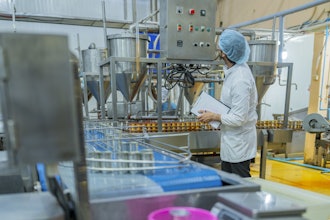
A manufacturer's ability to scale up quickly for major projects or meet peak seasonal demand hinges on having a flexible and reliable contingent workforce, and no more so than in food and beverage. However, relying on temporary staff presents a unique set of challenges, most notably the need for rapid, effective onboarding that doesn't compromise safety or productivity.
Traditional on-floor shadow training has been used to some effect, but it can be inconsistent, time- and labor-consuming, and cause productivity losses or safety breaches. This cannot be said for the new breed of digitally-integrated workforce systems, which are uniquely positioned to help train new recruits.
Manufacturing turnover rates are already high – a recent McKinsey & Company report highlighted that manufacturing turnover rates can reach 36.6% per year. Seasonal or not, this is a costly cycle of recruitment and retraining that impacts temporary and permanent staff alike. And the pool of temporary workers is vast. The U.S. Bureau of Labor Statistics reports 6.9 million people hold contingent jobs as their sole or main job. These workers do not have an implicit or explicit contract for ongoing employment in their jobs.
Tapping into this temporary workforce pool during peak times is a necessary part of manufacturing business strategy and is where a digital approach to temporary workforce management becomes essential. Instead of viewing training as an unavoidable cost center for new hires, it needs to be transformed into an effective, efficient process that accelerates time to productivity and reduces business risk.
Connected worker platforms are ready and waiting to answer the rallying cry for much-needed temporary workers.
Train: Quickly, efficiently, and safely onboard temporary hires
From a regulatory perspective, temporary worker training is required by the Occupational Safety and Health Administration (OSHA) to be identical or equivalent to the training provided to regular employees. The issue is that temporary workers usually join a factory workforce at peak time, so time and resources for training are already stretched.
Traditional shadowing and classroom training methods can differ from one trainer to the next, introducing potential inconsistencies for new seasonal recruits who need to get up to speed quickly and safely. But video lessons delivered through a connected worker application help close the skills gap and enhance training, increasing productivity and reducing human error.
On-Demand training ticks the boxes
Consider a 500-employee factory specializing in the production of medical nutrition. Faced with the need to quickly train a new wave of operators while expanding operations, it adopted a modern training solution—the connected worker platform from Poka. It was able to provide new hires with real-time access to training videos, digital work instructions, and troubleshooting tips directly on the factory floor, enabling a more immediate learning process. By incorporating support for real-time training at the point of need, the factory reduced shadowing time and overstaffing costs by 40%, accelerating the onboarding process.
Fast-tracking and reducing the cost of training for temporary workforces in this way allows businesses to meet fluctuating production demands with more agility.
Equip: Set seasonal workers up for success
By leveraging a connected worker platform, manufacturers provide recruits with immediate access to clear video lessons and digital work instructions. But the goal isn't just to get temporary workers on the floor faster; it is to equip them with the knowledge and confidence to work safely and productively from day one, turning a potential liability into a productive part of the factory team.
Overcoming Language Barriers
For a high proportion of temporary workers, English is not their first language, so here the connected worker platform's ability to provide AI-driven bilingual translation of work instructions and continuous training is essential to serve up key information in a way that is best absorbed by individual workers, and in their own language.
Neural machine translation services can deliver fast, high-quality, affordable, customizable language translation to convert spoken language into text in real time. This technology continuously refines its understanding of language nuances, dialects, and industry-specific terminology, making it essential for the manufacturing environment.
By providing real-time, accurate transcriptions in multiple languages, these tools ensure that all employees, regardless of their native language, can access and understand critical safety protocols and standard operating procedures (SOPs). This inclusivity not only enhances operational safety but also reduces errors and promotes a higher standard of work.
Turbo-charging your contingent workforce will benefit the business and temporary hires
Connected worker platforms are a win-win for both manufacturers and the temporary workforce.
By reducing the time and resources needed for onboarding and training, manufacturers themselves can quickly scale their operations to meet peak seasonal demand without compromising safety or quality.
Connected worker platforms reduce the risk of human error and safety breaches by providing consistent, up-to-date instructions and real-time guidance. As a result, they transform a temporary workforce from a potential liability into a flexible, highly productive asset that drives efficiency and resilience across the entire manufacturing operation.
For the temporary workers now entering the factory, they are equipped with the right tools and training from day one. Access to on-demand training modules, digital work instructions, and real-time support allows these workers to learn by doing, troubleshooting issues and mastering new tasks with a level of independence not possible with traditional training approaches. This structured and continuous learning environment ensures that temporary hires gain valuable, transferable skills during their tenure, boosting their confidence and making them more effective contributors while they are employed.
A temporary assignment goes from a short-term solution to a meaningful professional development opportunity for the individual—creating a more skilled and reliable talent pool for the industry as a whole.






















